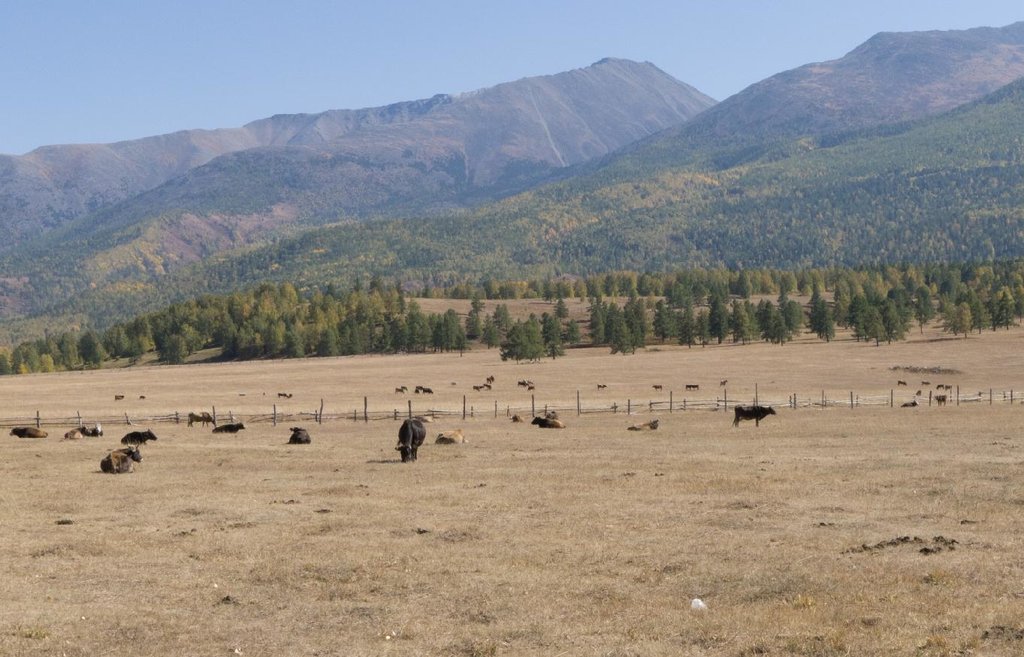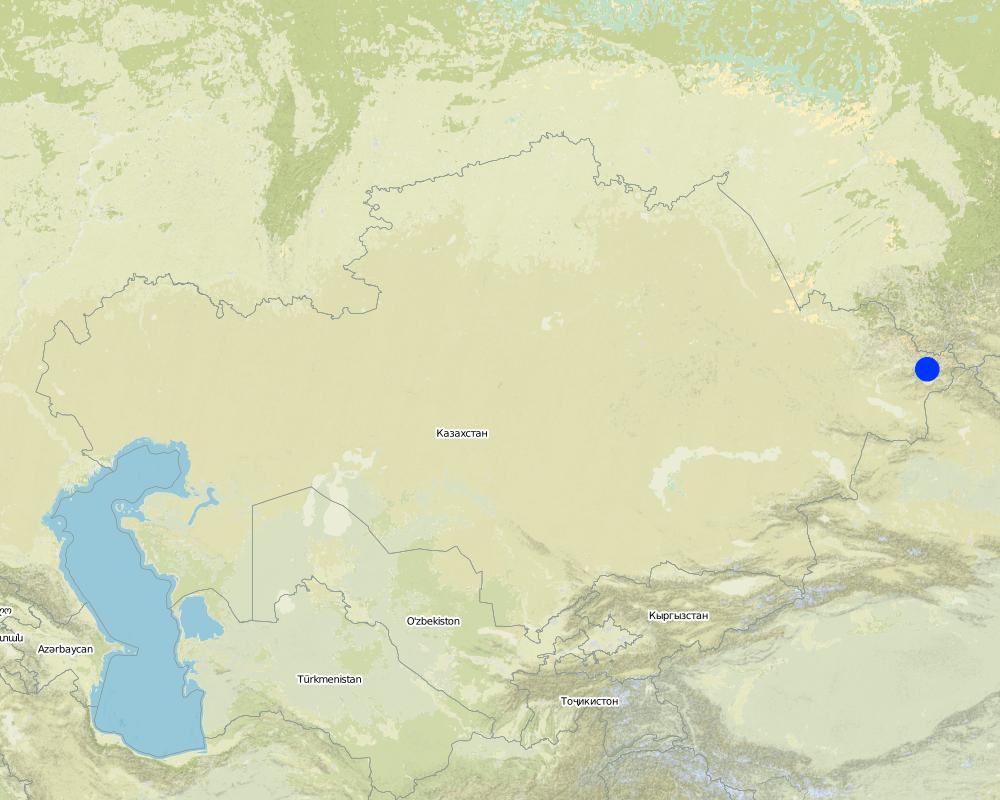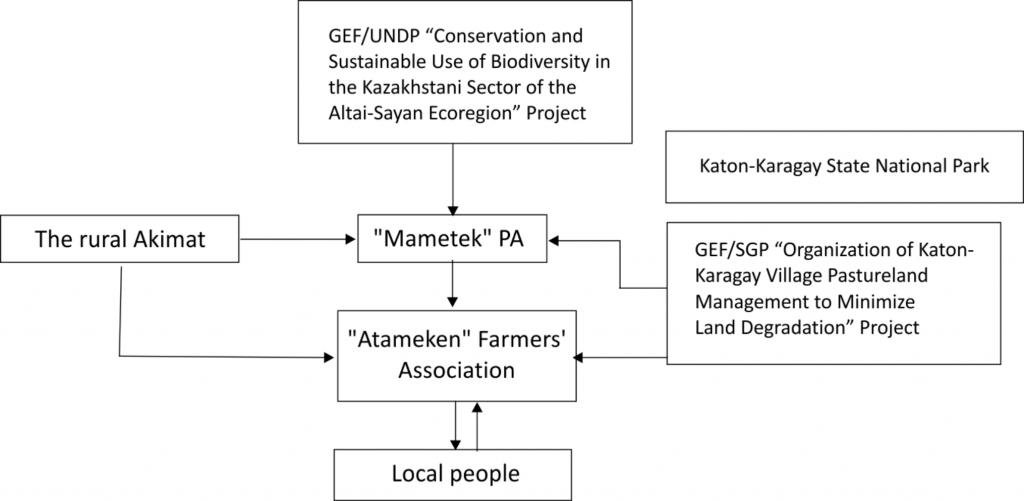Rangeland management through the restoration of distant stock-breeding systems and the drastic improvement of rangelands [Kazakhstan]
- Creation:
- Update:
- Compiler: Konstantin Pachikin
- Editor: –
- Reviewer: David Streiff
Казахстан - Инициатива Стран Центральной Азии по Управлению Земельными Ресурсами (CACILM/ИСЦАУЗР)
approaches_2455 - Kazakhstan
View sections
Expand all Collapse all1. General information
1.2 Contact details of resource persons and institutions involved in the assessment and documentation of the Approach
SLM specialist:
Name of project which facilitated the documentation/ evaluation of the Approach (if relevant)
Central Asian Countries Initiative for Land Management (CACILM I)Name of the institution(s) which facilitated the documentation/ evaluation of the Approach (if relevant)
Kazakh Institute of Soil Science and Agrochemistry - Kazakhstan1.3 Conditions regarding the use of data documented through WOCAT
The compiler and key resource person(s) accept the conditions regarding the use of data documented through WOCAT:
Yes
1.4 Reference(s) to Questionnaire(s) on SLM Technologies
2. Description of the SLM Approach
2.1 Short description of the Approach
The restoration of degraded rangelands and the improvement of their productivity through the organization of distant stock-breeding and the introduction of pasture rotation (in the frame of CACILM).
2.2 Detailed description of the Approach
Detailed description of the Approach:
Aims / objectives: The main goal is the restoration of degraded pastures through a revival of the traditional method of stock-breeding (seasonal distant livestock pasturing) using modern methods of land area organization (introduction of pasture rotation with regulated load) with far-ranging inclusion of local population
Methods: The amount of livestock has considerably increased in Katon-Karagay district for the last years. As a result, the livestock concentrates around the villages, and unsystematic and uncontrolled pasture use leads to the loss of valuable forage grasses and an aggravation of land degradation. Within the framework of the GEF/SGP “Organization of Katon-Karagay Village Pastureland Management to Minimize Land Degradation” Project a scheme for pastureland restoration including the organization of traditional seasonal distant pasturing as well as the introduction of a pasture rotation system around Katon-Karagay village was developed
Stages of implementation: A number of meetings with the local population and workshops were organized by a group of the GEF/UNDP Project consultants. As a result of the activities of this initiative group, the 'Mametek' Public Association was established. Within the same framework, the pasturelands in the surrounding areas of Katon-Karagay State National Natural Park were examined. As a result of that examination, a plan to restore and improve the pasturelands was developed by the project staff. A scheme of pasture rotation was designed for Katon-Karagay village by the GEF/SGP Project staff, according to which the pastures around the villages were divided in 4 areas; the sequence of grazing in the areas; and the norms of pasture load were defined. All areas were fenced. An agreement on joint activity between local administration, 'Mametek' Public association and 'Atameken' Farmers’ Association was signed. New system of distant stock-breeding was established in a high mountain pasture . Equipment for stock-breeders was purchased.
Role of stakeholders: GEF/SGP “Organization of Katon-Karagay Village Pastureland Management to Minimize Land Degradation” Project is responsible for general management and initial financial support. Pastures were examined and the action plan was developed under the GEF/UNDP Project. Rural Akimat provides land for lease and regulates legal obligations and contracts. Local inhabitants are the main actors implementing the agreed upon activities in the target area (fencing and guarding the areas) and direct work regarding livestock grazing. 'Mametek' PA conducts direct organizational activity, supervises implementation of the activities (the order of grazing in the areas, grazing norms and loads) and settles conflicts. 'Atameken' Farmers Association implements the organization of livestock grazing and works in accordance with the pasture rotation scheme and attracts/hires workers. Katon-Karagay National Park is concerned with the biodiversity conservation of its area, and provides methodical support
2.3 Photos of the Approach
2.5 Country/ region/ locations where the Approach has been applied
Country:
Kazakhstan
Region/ State/ Province:
East-Kazakhstan
Further specification of location:
Katon-Karagay
Map
×2.6 Dates of initiation and termination of the Approach
Indicate year of initiation:
2009
Year of termination (if Approach is no longer applied):
2010
2.7 Type of Approach
- project/ programme based
2.8 Main aims/ objectives of the Approach
The Approach focused mainly on SLM with other activities
To secure pasturing using distant rangelands To organize pasture rotation to restore forage resources of pastures in surrounding areas of villages
The SLM Approach addressed the following problems: Reduction of pasture productivity, Soil degradation, Conflicts related to land area use
2.9 Conditions enabling or hindering implementation of the Technology/ Technologies applied under the Approach
social/ cultural/ religious norms and values
- hindering
Misunderstanding of people in the need to apply the approach
Treatment through the SLM Approach: Explanations through meetings, seminars
institutional setting
- hindering
The lack of an institutional structure that would control the organization of grazing activities
Treatment through the SLM Approach: Establishment of the NGO Mametek
legal framework (land tenure, land and water use rights)
- enabling
The State National Park, which is concerned in the restoration the area’s biological diversity, is the landowner of distant pasturelands. The Akimat is the owner of the land areas surrounding the village.
workload, availability of manpower
- hindering
Lack of shepherds in surrounding and distant pastures in the first year because of a poor understanding of the benefits of the new grazing system
Treatment through the SLM Approach: People had realized that those who joined the new grazing scheme had benefits and they wanted to join as well
3. Participation and roles of stakeholders involved
3.1 Stakeholders involved in the Approach and their roles
- local land users/ local communities
Women mainly deal with housekeeping
Concerned in land use for pasturing
- community-based organizations
'Atameken' Farmers' assosiation
- SLM specialists/ agricultural advisers
- NGO
Mametek
- local government
Rural akimat
The Akimat is concerned with the improvement of people’s well-being
- national government (planners, decision-makers)
The National Park is concerned with the conservation and restoration of the area
3.2 Involvement of local land users/ local communities in the different phases of the Approach
| Involvement of local land users/ local communities | Specify who was involved and describe activities | |
|---|---|---|
| initiation/ motivation | external support | During the initial stage, meetings and workshops were organized to explain the need for land restoration |
| planning | passive | |
| implementation | interactive | The local population actively participates in the implementation of the approach through pasturing livestock in accordance with the project plan |
| monitoring/ evaluation | interactive | Контроль за выполнением мероприятий, оценка состояния пастбищ |
| Research | none |
3.3 Flow chart (if available)
Description:
As a result 'Mametek' PA, was founded which serves as the link between GEF/SGP Project, the Akimat and the 'Atameken' Farmers’ Association. Katon-Karagay National Park provides the land for pastures
Author:
Konstantin Pachikin (Almaty)
3.4 Decision-making on the selection of SLM Technology/ Technologies
Specify who decided on the selection of the Technology/ Technologies to be implemented:
- SLM specialists alone
Explain:
The specialists of the GEF/UNDP “Conservation and Sustainable Use of Biodiversity in the Kazakhstani Sector of the Altai-Sayan Ecoregion” Project conducted the work with the local population explaining the need in due arrangement of pasture use to prevent degradation and restore vegetation. After this, the local population expressed their desire to initiate and realize the approach
Decisions on the method of implementing the SLM Technology were made by mainly by land users supported by SLM specialists
4. Technical support, capacity building, and knowledge management
4.1 Capacity building/ training
Was training provided to land users/ other stakeholders?
Yes
Specify who was trained:
- land users
Form of training:
- public meetings
Form of training:
- «Learning for sustainability» проведен ОФ «CAMP-Co
Subjects covered:
Explanation of the need for pasture rotation, its advantages and methods of implementation
4.2 Advisory service
Do land users have access to an advisory service?
No
4.3 Institution strengthening (organizational development)
Have institutions been established or strengthened through the Approach?
- yes, a little
Specify the level(s) at which institutions have been strengthened or established:
- local
- Indirectly, by reducing the workload of the akimat
Give further details:
Indirectly, through a reduction in workload: there is no need for the Akmat to check the pastures’ condition, since these responsibilities have been transferred to “Mametek” PA
4.4 Monitoring and evaluation
Is monitoring and evaluation part of the Approach?
Yes
Comments:
Economic / production aspects were regular monitored by land users through measurements; indicators: Supervision over a condition of a vegetative cover are lead
Bio-physical aspects were regular monitored by land users through observations
There were no changes in the Approach as a result of monitoring and evaluation
There were no changes in the Technology as a result of monitoring and evaluation
4.5 Research
Was research part of the Approach?
No
5. Financing and external material support
5.1 Annual budget for the SLM component of the Approach
If precise annual budget is not known, indicate range:
- 10,000-100,000
Comments (e.g. main sources of funding/ major donors):
Approach costs were met by the following donors: international (Project “Organization of Katon-Karagay Village Pastureland Management to Minimize Land Degradation” ): 70.0%; local government (district, county, municipality, village etc) (Akimat): 20.0%; local community / land user(s) (developed free of charge by means organization and use of land areas (fencing)): 10.0%
5.2 Financial/ material support provided to land users
Did land users receive financial/ material support for implementing the Technology/ Technologies?
Yes
If yes, specify type(s) of support, conditions, and provider(s):
State subsidies for seeds
5.3 Subsidies for specific inputs (including labour)
- equipment
| Specify which inputs were subsidised | To which extent | Specify subsidies |
|---|---|---|
| machinery | partly financed | |
- agricultural
| Specify which inputs were subsidised | To which extent | Specify subsidies |
|---|---|---|
| seeds | fully financed | |
- construction
| Specify which inputs were subsidised | To which extent | Specify subsidies |
|---|---|---|
| stone | fully financed | |
| wood | fully financed | |
If labour by land users was a substantial input, was it:
- paid in cash
Comments:
'Mametek' PA pays cash work of shepherds
5.4 Credit
Was credit provided under the Approach for SLM activities?
No
6. Impact analysis and concluding statements
6.1 Impacts of the Approach
Did the Approach help land users to implement and maintain SLM Technologies?
- No
- Yes, little
- Yes, moderately
- Yes, greatly
The vegetation cover around the village has been restored. The productivity of crop lands has increased. The profit of land users has increased
Did the Approach empower socially and economically disadvantaged groups?
- No
- Yes, little
- Yes, moderately
- Yes, greatly
These groups do not participate in the approach’s implementation
Did other land users / projects adopt the Approach?
- No
- Yes, little
- Yes, moderately
- Yes, greatly
The inhabitants moved their livestock to the system of pasture rotation and distant pastures. Previously, the inhabitants had no opportunity for animal grazing in distant pastures
Did the Approach lead to improved livelihoods / human well-being?
- No
- Yes, little
- Yes, moderately
- Yes, greatly
The amount of forage in the surrounding areas of the village has increased. The weight of the livestock has increased. The profit of land users has increased
Did the Approach help to alleviate poverty?
- No
- Yes, little
- Yes, moderately
- Yes, greatly
The number of animals has increased; the expenses for livestock growing and maintenance have reduced
6.2 Main motivation of land users to implement SLM
- increased profit(ability), improved cost-benefit-ratio
- well-being and livelihoods improvement
6.3 Sustainability of Approach activities
Can the land users sustain what has been implemented through the Approach (without external support)?
- yes
If yes, describe how:
The example of the land users participating in the approach’s implementation will urge some rural inhabitants to join and even to expand the activity
6.4 Strengths/ advantages of the Approach
| Strengths/ advantages/ opportunities in the land user’s view |
|---|
| The condition of pastures in the areas surrounding the village has improved How to sustain/ enhance this strength: To raise population’s awareness on correct pasture use |
| Strengths/ advantages/ opportunities in the compiler’s or other key resource person’s view |
|---|
| Low running expenses; How to sustain/ enhance this strength:Despite high enough initial expenses, the subsequent current expenses are insignificant and there is no necessity to improve this strength |
| High cost efficiency |
| The developed steady interconnected scheme of Akimat - OO Mametek - PA Atameken which has allowed to introduce the given approach (the state and economic structures, local community |
| Restoration of the degraded pastures and increase of their efficiency; How to sustain/ enhance this strength: Renewal of a traditional way of agriculture and pasture rotation |
| Support from the population and local authorities |
6.5 Weaknesses/ disadvantages of the Approach and ways of overcoming them
| Weaknesses/ disadvantages/ risks in the land user’s view | How can they be overcome? |
|---|---|
| The land does not belong to land users, but is provided by short-term leases. It is not clear, whether the lease will be extended. | Efforts should be made to renew the lease when it expires |
| Weaknesses/ disadvantages/ risks in the compiler’s or other key resource person’s view | How can they be overcome? |
|---|---|
| The land does not belong to land users, but is provided by short-term leases. It is not clear, whether the lease will be extended. | Efforts should be made to renew the lease when it expires |
7. References and links
7.2 References to available publications
Title, author, year, ISBN:
Management of pasturable дфтвы in village Katon-Karagaj village (results of the project), 2010
Available from where? Costs?
from. Katon-Karagai
Links and modules
Expand all Collapse allLinks
No links
Modules
No modules







